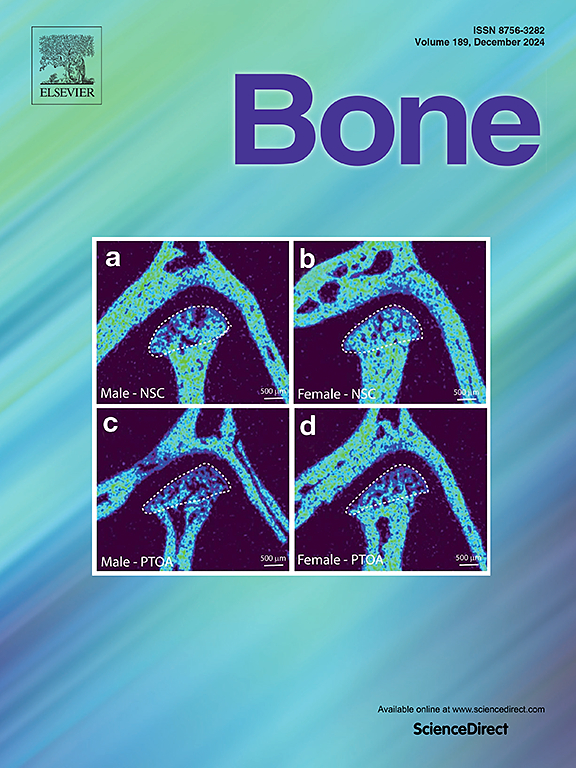患有长期1型糖尿病的青少年骨量低,反映骨吸收改变的骨指数水平降低
IF 3.5
2区 医学
Q2 ENDOCRINOLOGY & METABOLISM
引用次数: 0
摘要
1型糖尿病(T1D)的患病率正在全球范围内增加,并与严重并发症相关,包括骨折风险增加。这项病例对照研究调查了与健康匹配的对照组相比,患有控制良好、持续时间较长的T1D的年轻人在骨量和骨生物标志物方面是否存在差异。50名患者,年龄15.0-17.9岁,T1D病程至少8年(平均±SD) 10.6±2.1年,因此参与者在青春期和生长高峰期的大部分时间都患有糖尿病。自糖尿病诊断以来,平均HbA1c为56±6 mmol/mol(7.3±0.6%)。骨量通过双能x线吸收仪和外周定量计算机断层扫描(pQCT)评估。临床随访数据来自瑞典国家糖尿病登记处。对照组为50名健康青少年,年龄15.1 ~ 17.9岁。这些小组在年龄、性别、体重、身高、体重指数和自我报告的体育活动方面没有显著差异。T1D个体的总体无头aBMD和z评分显著低于T1D个体,p <;0.05. pQCT显示,T1D组总胫骨密度和骨小梁密度均较低,p <;0.05. 甲状旁腺激素、25-羟基维生素D、骨特异性碱性磷酸酶(BALP)、完整前胶原I型n -前肽(PINP)、硬化蛋白、生物活性硬化蛋白和骨保护素组间无差异。然而,T1D患者的I型胶原c末端末端肽(CTX)水平降低(p <;0.001)和核因子κB配体(又名RANKL) (p = 0.01),表明破骨细胞的调节发生了改变。总之,控制良好、持续时间较长的T1D的年轻人骨量积累低于正常水平,多个部位的微观结构受损,rankl介导的破骨细胞生成受到抑制,导致骨吸收减少。基于这些发现,我们建议在儿童糖尿病护理中监测骨骼健康,以便在易感个体的生命早期进行潜在干预,以达到最佳峰值骨量。本文章由计算机程序翻译,如有差异,请以英文原文为准。
Adolescents with long-duration type 1 diabetes have low bone mass and reduced levels of bone indices reflecting altered bone resorption
The prevalence of type 1 diabetes (T1D) is increasing globally and is associated with severe complications, including an increased risk of fractures. This case-control study investigated whether young individuals with well-controlled, long-duration T1D have differences in bone mass and bone biomarkers in comparison with healthy matched controls. Fifty individuals, aged 15.0–17.9 years, with a T1D duration of at least 8 years and (mean ± SD) 10.6 ± 2.1 years were included, hence the participants had diabetes throughout most part of their puberty and growth spurt. The mean HbA1c since diabetes diagnosis was 56 ± 6 mmol/mol (7.3 ± 0.6 %). Bone mass was assessed by dual-energy X-ray absorptiometry and peripheral quantitative computed tomography (pQCT). Clinical follow-up data were retrieved from the Swedish National Diabetes Registry. The control group comprised 50 healthy matched adolescents, aged 15.1–17.9 years. The groups were well-matched with no significant differences in age, sex, weight, height, body mass index and the self-reported physical activity. Total body less head aBMD and Z-scores were significantly lower in T1D individuals, p < 0.05. Total tibia density and trabecular density, by pQCT, were also lower in the T1D group, p < 0.05. There were no differences between the groups for parathyroid hormone, 25-hydroxyvitamin D, bone-specific alkaline phosphatase (BALP), intact procollagen type I N-propeptide (PINP), sclerostin, bioactive sclerostin and osteoprotegerin. However, individuals with T1D had reduced levels of C-terminal telopeptide of type I collagen (CTX) (p < 0.001) and nuclear factor κB ligand (a.k.a. RANKL) (p = 0.01), indicating altered regulation of osteoclasts. In conclusion, young individuals with well-controlled, long-duration T1D have subnormal bone mass accrual, impaired microstructure at several sites and suppressed RANKL-mediated osteoclastogenesis resulting in reduced bone resorption. Based on these findings, we suggest that bone health should be monitored in pediatric diabetes care to potentially intervene early in life in susceptible individuals to achieve optimal peak bone mass.
求助全文
通过发布文献求助,成功后即可免费获取论文全文。
去求助
来源期刊

Bone
医学-内分泌学与代谢
CiteScore
8.90
自引率
4.90%
发文量
264
审稿时长
30 days
期刊介绍:
BONE is an interdisciplinary forum for the rapid publication of original articles and reviews on basic, translational, and clinical aspects of bone and mineral metabolism. The Journal also encourages submissions related to interactions of bone with other organ systems, including cartilage, endocrine, muscle, fat, neural, vascular, gastrointestinal, hematopoietic, and immune systems. Particular attention is placed on the application of experimental studies to clinical practice.
 求助内容:
求助内容: 应助结果提醒方式:
应助结果提醒方式:


